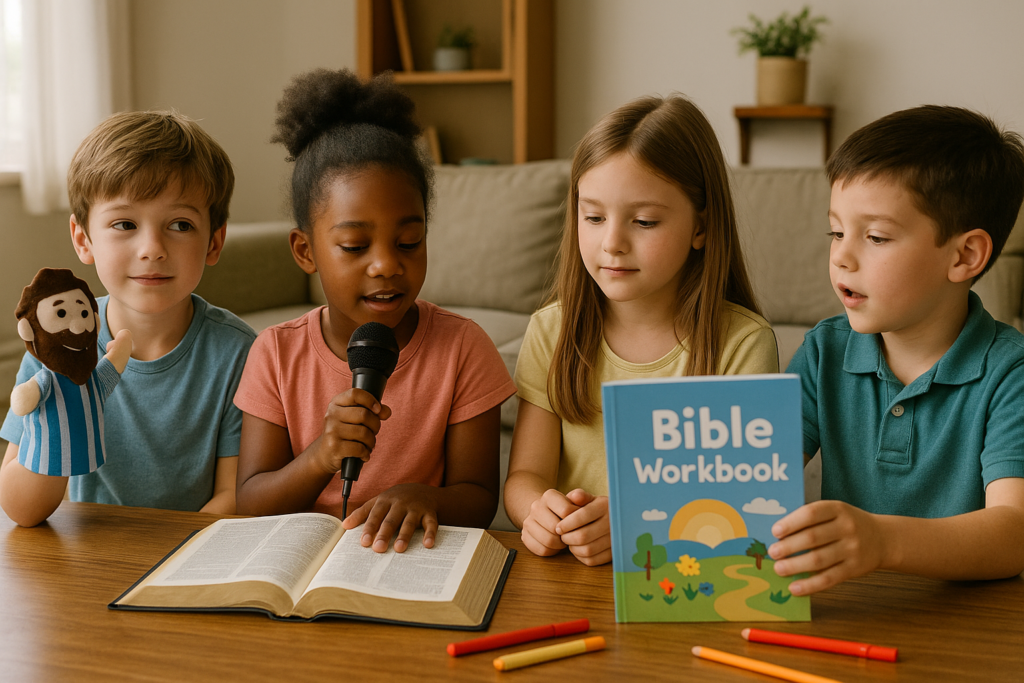Fostering a deep understanding and love of Scripture in children begins right at home. By leveraging creative methods, parents can transform Bible lessons into treasured moments. Whether you’re teaching during busy evenings or peaceful weekends, various engaging strategies can help keep kids excited to learn. A structured Bible study curriculum for kids can provide valuable support and guidance, ensuring lessons are organized and developmentally appropriate as you nurture your child’s spiritual growth. With countless resources available today, parents have more options than ever to personalize their family’s approach. Combining hands-on activities, storytelling, and technology can cultivate knowledge and a lasting love of God’s Word. Here are some creative ways to make biblical lessons memorable and meaningful for children at home.
Table of Contents
Interactive Storytelling
Stories are the heartbeat of childhood learning, and Bible stories provide timeless lessons that can be retold in new ways. Interactive storytelling allows kids to become active participants in the narrative. Gather props from around the house, use simple costumes, or make stick puppets to act out characters like Noah, Moses, or Esther. Encourage kids to ask questions, predict what happens next, or express how they think a character felt during key moments. For instance, when retelling the story of Jesus calming the storm, create “waves” with blankets and let children shout along, then “calm” the sea with their gentle voices.
Arts and Crafts
Arts and crafts foster creativity while reinforcing biblical lessons visually and tactilely. After exploring a Bible story, invite children to make crafts connected to the key message. For example, following the story of the Good Samaritan, kids can create a collage showcasing acts of kindness or assemble first-aid kits as a reminder of compassion. For the story of creation, let them design a mural featuring animals, stars, and plants. Display these crafts around the home as a reminder of spiritual learning and achievement.

Music and Songs
Music is a powerful memory aid and makes Scripture come alive. Singing songs about Bible stories or characters—complete with hand motions and simple choreography—can help children internalize lessons and enjoy learning. Create a playlist of classic Christian children’s songs or even write new lyrics together based on the stories studied that week. Dance parties and sing-alongs can become a cherished part of your family’s Bible routine, providing a joyful context for learning about God’s love and promises.
Games and Activities
Games add excitement and reinforce comprehension through play. Organize scavenger hunts where children find items representing parts of a Bible narrative—fish and bread for the feeding of the 5,000, or small hearts to remind them of love and forgiveness. Matching games with images or words from stories reinforce memory, while themed charades or Bible bingo keep engagement high. Tailoring games to a specific lesson helps children build confidence as they master biblical concepts.
Utilizing Technology
The digital age offers innovative ways for children to explore the Bible. Interactive apps, animated videos, and kid-friendly quizzes can bring Bible stories to life while catering to different learning styles. Look for apps and websites that are age-appropriate, visually engaging, and theologically sound. Podcasts and audio Bibles allow children to listen to stories on the go. At the same time, video calls with extended family can be an opportunity to share what they’ve learned, fostering connection and accountability.
Role-Playing and Dramatizations
Letting children step into the shoes of Bible characters through role-play helps them empathize with the lessons being taught. Assign roles for a simple drama production at home—maybe one child is Daniel facing the lions while another is the angel sent by God. Include costumes made from blankets or paper for added immersion. Afterward, discuss each character’s emotions, allowing children to draw deeper connections to faith and perseverance.
Nature Walks and Creation
Nature is a living classroom for reflecting on God’s creation. Take your children outdoors for a nature walk, encouraging them to spot birds, flowers, insects, or unique trees. Discuss how each part of creation showcases God’s careful design and creativity. Please bring a notebook for children to sketch what they see or collect interesting leaves and stones. Connect these observations to Bible stories—such as the sparrow in Jesus’ teaching or the plants in Genesis—making spiritual truths tangible and wondrous.
Cooking with a Biblical Twist
Cooking and baking can be delightfully multisensory approaches to learning. Prepare dishes mentioned in the Bible, like unleavened bread, while discussing the Exodus story, or make fish-shaped treats when talking about Jesus’s miracles. Use mealtime as an opportunity to recall Bible verses or explore the cultural context of certain foods. Cooking together provides a taste-driven experience that links faith to daily family rituals, making Scripture relatable and memorable.
By embracing creativity in Bible teaching at home, parents can nurture curiosity, faith, and unity within the family. These methods make learning the Bible engaging and foster lifelong connections to God’s Word, laying a foundation for spiritual growth that will endure throughout childhood and beyond.


